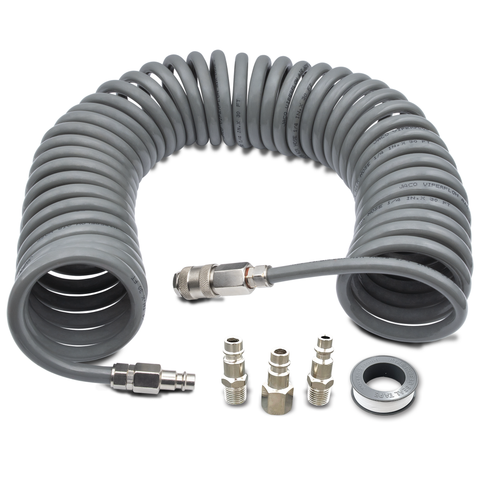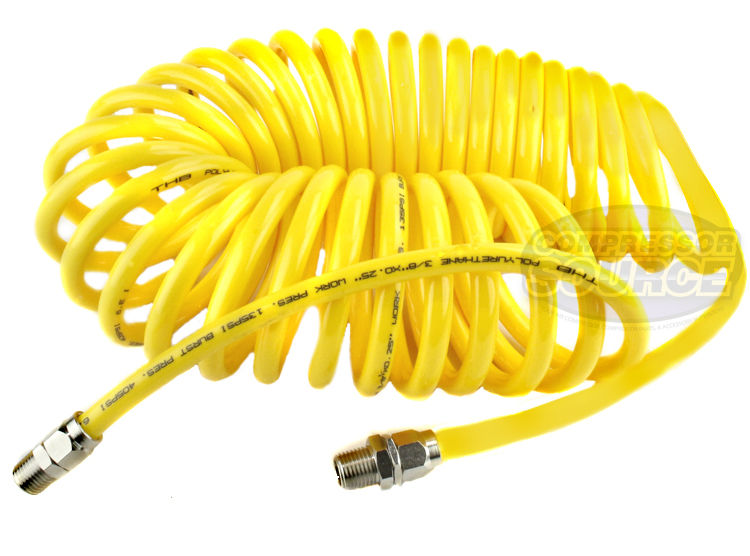Are you tired of tangled hoses slowing down your work? A coiled air compressor hose could be the simple solution you need.
It’s designed to stretch when you need it and spring back neatly when you don’t. Imagine having a workspace free from clutter, where your hose stays organized and ready at a moment’s notice. You’ll discover how choosing the right coiled air compressor hose can save you time, reduce frustration, and make your tasks easier.
Keep reading to find out what makes these hoses stand out and how to pick the perfect one for your needs.
Benefits Of Coiled Air Compressor Hoses
Coiled air compressor hoses offer several benefits that improve work efficiency and convenience. These hoses are designed to save space, making them ideal for small work areas. Their unique coil shape allows easy handling and quick storage. They also provide excellent flexibility, which helps users reach different angles without hassle.
Space-saving Design
The coiled shape keeps the hose compact and neat. It takes up less space than traditional hoses. This design helps keep work areas clean and organized. It fits well in tight spots and small workshops. No more tangled hoses cluttering your workspace.
Ease Of Use And Storage
Coiled hoses are easy to carry and move around. They stretch only when needed and return to their original shape. This reduces tripping hazards and hose damage. Storing them is simple—they coil back automatically. You save time winding and unwinding the hose.
Enhanced Flexibility
The coil design allows hoses to bend and twist easily. It reaches around corners and into hard-to-access spots. Users can work comfortably without pulling or straining. Flexible hoses reduce wear and extend the hose’s life. They support smooth and efficient air flow during use.

Credit: jacosuperiorproducts.com
Materials And Construction
The materials and construction of a coiled air compressor hose determine its performance and lifespan. These hoses must be strong and flexible. They face pressure, bending, and rough conditions daily. Choosing the right materials and construction methods ensures the hose works well and lasts long.
Common Hose Materials
Coiled air compressor hoses are often made from PVC, polyurethane, or rubber. PVC is light and easy to handle. Polyurethane offers better flexibility and resists wear. Rubber hoses are tough and handle high pressure well. Each material suits different jobs and environments.
Reinforcement Techniques
Reinforcement makes hoses stronger and safer. Many hoses have braided or spiral layers inside. These layers keep the hose from bursting under pressure. They also help the hose keep its shape after stretching. Reinforcement supports both durability and flexibility.
Impact On Durability
Good materials and solid construction improve hose life. A well-made hose resists cracks, kinks, and leaks. It works well in cold, heat, or rough use. Durable hoses reduce downtime and maintenance costs. They provide safe and steady air flow for tools and machines.
Choosing The Right Hose Size
Choosing the right hose size for your coiled air compressor hose is key. The correct size ensures good airflow and efficient work. A wrong size can cause pressure loss or damage to your tools. Focus on three main factors: diameter, length, and pressure ratings. Each plays a role in hose performance and durability.
Diameter Considerations
The hose diameter affects air flow volume. A larger diameter allows more air to pass through. This is important for powerful tools that need high air volume. Smaller diameters can restrict air, causing tools to work slower. Match the diameter to your tool’s air requirements for best results.
Length And Coil Size
Length affects how far you can reach with the hose. Longer hoses give more flexibility but can reduce air pressure. Coiled hoses save space and avoid tangles. Choose a coil size that fits your workspace. Avoid very long hoses if pressure drop is a concern.
Pressure Ratings
Pressure rating shows the maximum air pressure the hose can handle. Use a hose with a rating higher than your compressor’s pressure. This prevents hose bursts and safety risks. Check the rating before buying to match your compressor and tools.

Credit: compressor-source.com
Maintenance Tips For Longevity
Proper maintenance keeps a coiled air compressor hose working well for years. Simple care steps prevent early wear and costly repairs. Follow these tips to extend your hose’s life.
Regular Inspection
Check the hose often for cracks, leaks, or weak spots. Look closely at the ends and the coil areas. Catching damage early stops bigger problems. Replace the hose if you see serious cuts or holes.
Cleaning Procedures
Clean the hose regularly to remove dirt and oil. Use a soft cloth and mild soap with water. Avoid harsh chemicals that can damage the hose material. Dry the hose fully before storing it to prevent mold and mildew.
Avoiding Common Damage
Do not stretch the hose too far. Avoid sharp bends or kinks, which cause cracks. Keep the hose away from hot surfaces and chemicals. Store it in a cool, dry place to keep it flexible and strong.
Applications And Use Cases
Coiled air compressor hoses serve many purposes across different fields. Their design offers flexibility and easy storage. These hoses handle air pressure well. They help connect tools to air compressors smoothly. Their use is common in several settings.
Industrial Settings
Factories and workshops use coiled air hoses often. They power pneumatic tools like drills and grinders. The hose’s coil shape keeps floors clear. It reduces tripping hazards and saves space. Workers move freely without hose tangles. These hoses also resist wear from rough use.
Automotive Workshops
Car repair shops rely on coiled air hoses daily. They connect to air tools for fixing vehicles. Mechanics use them for tire inflation, painting, and cleaning. The hose’s stretch and recoil make work easy. It reaches tight spaces without extra effort. The durability fits the busy workshop environment.
Home Diy Projects
Many homeowners find coiled air hoses useful for DIY tasks. They connect to small compressors for airbrushing or nailing. The hose’s compact size fits home garages well. It stores neatly without clutter. Hobbyists enjoy the hose’s ease of use. It supports various small projects without hassle.

Credit: www.amazon.com
Troubleshooting Common Issues
Troubleshooting common issues with coiled air compressor hoses helps keep your tools working well. Regular checks find small problems before they grow. Fixing these issues saves time and money.
Hoses wear out from use and weather. Knowing how to spot and fix problems keeps air flowing smoothly. Here are some common problems and easy solutions.
Leaks And Punctures
Leaks reduce air pressure and slow work. Check hoses for holes or cracks. Use soapy water to find bubbles at leak points. Small holes can be patched with repair tape or sealant. Replace the hose if damage is large.
Kinks And Coil Deformation
Kinks block air flow and strain the hose. Avoid sharp bends and tight loops. Gently stretch the hose to restore its shape. Store the hose properly on a reel or hanger. Replace if the coil loses shape permanently.
Connection Problems
Loose or damaged fittings cause air leaks. Tighten connections with a wrench but avoid over-tightening. Check seals and O-rings for wear. Replace worn parts to keep a tight seal. Use thread tape on threaded joints for better grip.
Upgrading For Better Performance
Upgrading your coiled air compressor hose can improve how well it works. New features and better materials make your hose last longer and perform better. Small changes can bring big benefits in daily use.
Choosing the right parts helps your system run smoothly. Strong connections stop leaks and keep air pressure steady. This means your tools get the power they need without interruption.
High-quality Fittings
Use fittings made from strong metals like brass or stainless steel. They resist rust and damage from rough use. Tight seals prevent air leaks and save energy. Easy-to-connect fittings reduce setup time and effort.
Heat And Chemical Resistance
Pick hoses that handle high temperatures well. Heat-resistant hoses avoid softening or breaking under stress. Chemical resistance protects the hose from oils and solvents. This keeps the hose safe and working longer in tough conditions.
Custom Coil Lengths
Custom lengths fit your workspace perfectly. Avoid too much slack that gets tangled or too short that limits movement. Proper coil size keeps your area tidy and safe. It also helps you work faster with less hassle.
Frequently Asked Questions
What Is A Coiled Air Compressor Hose?
A coiled air compressor hose is a flexible, spiral-shaped tube. It connects air compressors to tools. Its coil design saves space and prevents tangling.
Why Choose A Coiled Hose Over Straight Hose?
Coiled hoses are compact and easy to store. They retract automatically, reducing tripping hazards. They offer better mobility in tight workspaces.
What Materials Are Used For Coiled Air Hoses?
Coiled air hoses are often made from polyurethane, nylon, or PVC. These materials are durable, lightweight, and resistant to kinks and abrasions.
How Do I Maintain A Coiled Air Compressor Hose?
Keep the hose clean and dry. Avoid sharp bends or overstretching. Store it coiled properly to extend its lifespan.
Conclusion
Coiled air compressor hoses offer great flexibility and easy storage. They save space and reduce tripping hazards in your workspace. These hoses stretch when needed and coil back quickly. They work well for many tasks, making your job easier. Choosing the right hose improves air flow and tool performance.
Keep your hose clean and check for damage often. This simple tool can make a big difference in your work. A good coiled hose is a smart addition to any toolkit.

